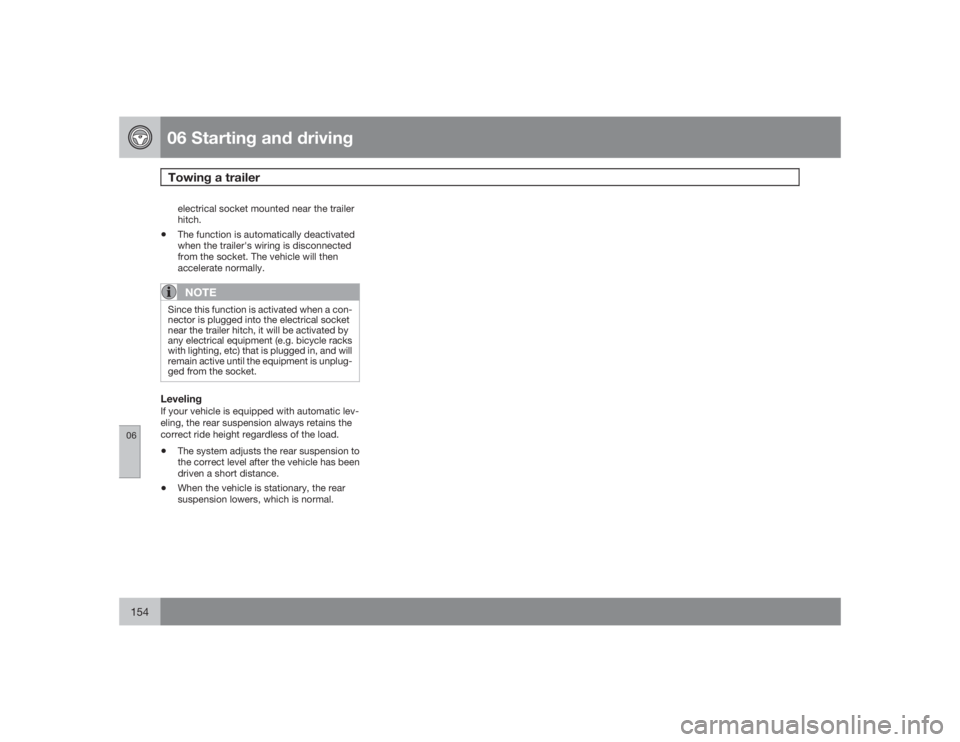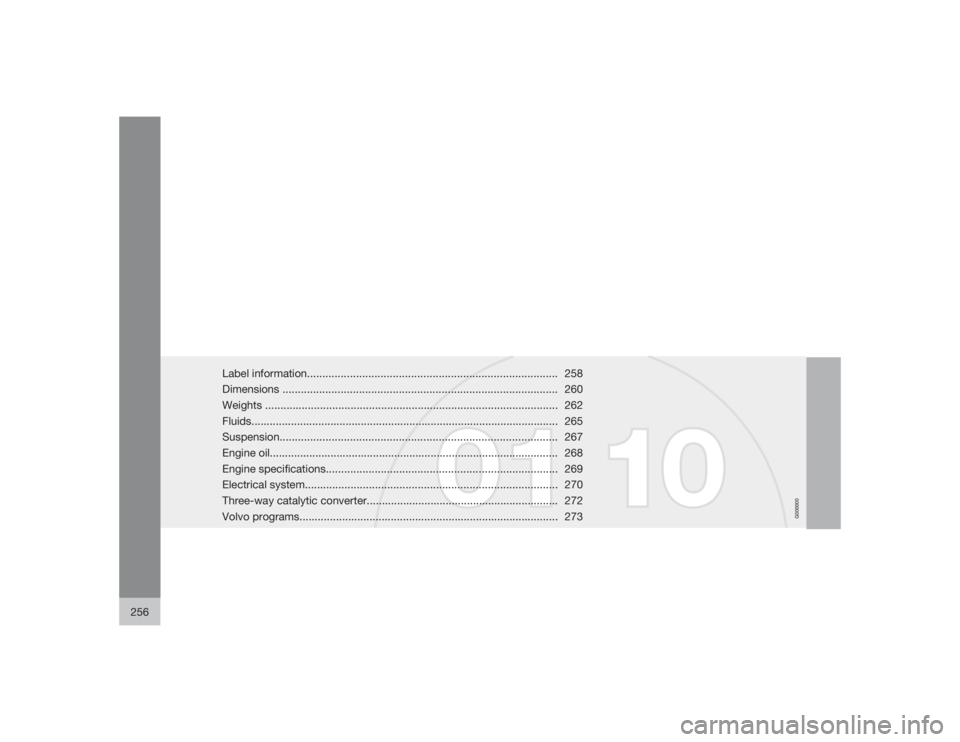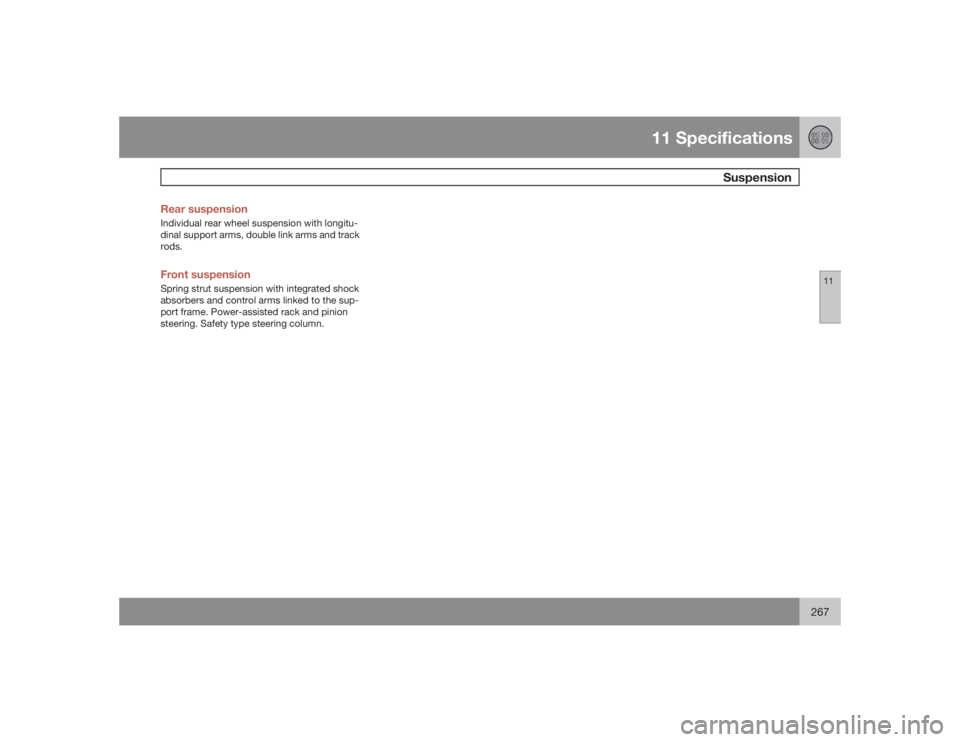2009 VOLVO XC90 suspension
[x] Cancel search: suspensionPage 7 of 282

Contents
7
09
09 Maintenance and servicingVolvo service........................................... 202
Maintaining your vehicle......................... 203
Working on your vehicle......................... 205
Engine compartment............................... 207
Engine oil................................................ 208
Fluids....................................................... 211
Wiper blades........................................... 213
Battery..................................................... 214
Replacing bulbs...................................... 217
Fuses....................................................... 224
10
10 AudioAudio system overview........................... 236
Audio system controls............................237
Radio functions....................................... 242
Sirius satellite radio................................. 244
Auxiliary equipment................................248
CD player/changer.................................. 249
Menu structure........................................ 252
Rear Seat Entertainment - Dual Screen
(RSE)–option.......................................... 253
11
11 SpecificationsLabel information.................................... 258
Dimensions............................................ 260
Weights ..................................................262
Fluids....................................................... 265
Suspension............................................. 267
Engine oil................................................ 268
Engine specifications.............................. 269
Electrical system..................................... 270
Three-way catalytic converter................. 272
Volvo programs....................................... 273
Page 152 of 282

06 Starting and drivingTowing a trailer
06152
NOTE
•
Recommended hitch tongue load:
not more than 10% of the trailer's
weight. The trailer load should be posi-
tioned so that it does not shift and the
tongue load should be 10% of the trail-
er's weight. However, the tongue load
should not exceed the maximum per-
missible weights indicated in the table
above.
•
When towing trailers without brakes,
the maximum permissible trailer weight
is 1,700 lbs (750 kg).
•
If necessary, redistribute the weight of
any cargo in the trailer to avoid exces-
sive weight on the trailer hitch.
•
The maximum trailer weight listed in the
table for All Wheel Drive models,
5,000 lbs (2250 kg) is only applicable
when there are not more than two occu-
pants in the vehicle, in the front seats,
with a combined weight of 300 lbs
(135 kg), with no other cargo in the vehi-
cle.
•
The maximum weight listed for Front
Wheel Drive models, 4,000 lbs (1800 kg)
is only applicable when there are not
more than four occupants in the vehicle,
in the front seats and second row of
seats, with a combined weight of
600 lbs (270 kg), with no other cargo in
the vehicle.
NOTE
•
Vehicles used for towing a trailer on a
regular basis, or for long-distance high-
way towing should be equipped with an
automatic transmission oil cooler and
Volvo's automatic self-leveling system
for the rear suspension. Consult your
Volvo retailer.
•
Volvo recommends the use of Volvo
trailer hitches that are specially
designed for the vehicle.
•
All Volvo models are equipped with
energy-absorbing shock-mounted
bumpers. Trailer hitch installation
should not interfere with the proper
operation of this bumper system.
•
Increase tire pressure to recommended
full inflation pressure. See chapter
"Wheels and tires."
•
When your vehicle is new, avoid towing
heavy trailers during the first 620 miles
(1,000 km).
•
Engine and transmission are subject to
increased loads. Therefore, engine
coolant temperature should be closely
watched when driving in hot climates or
hilly terrain. Use a lower gear and turn
off the air conditioner if the temperature
gauge needle enters the red range.
Page 154 of 282

06 Starting and drivingTowing a trailer
06154
electrical socket mounted near the trailer
hitch.
•
The function is automatically deactivated
when the trailer's wiring is disconnected
from the socket. The vehicle will then
accelerate normally.NOTE
Since this function is activated when a con-
nector is plugged into the electrical socket
near the trailer hitch, it will be activated by
any electrical equipment (e.g. bicycle racks
with lighting, etc) that is plugged in, and will
remain active until the equipment is unplug-
ged from the socket.LevelingIf your vehicle is equipped with automatic lev-
eling, the rear suspension always retains the
correct ride height regardless of the load.•
The system adjusts the rear suspension to
the correct level after the vehicle has been
driven a short distance.
•
When the vehicle is stationary, the rear
suspension lowers, which is normal.
Page 177 of 282

07 Wheels and tires
Snow chains, snow tires, studded tires
07
177 Snow chains
Snow chains can be used on your Volvo with
the following restrictions:•
Snow chains should be installed on front
wheels only. Use only Volvo approved
snow chains.
•
If accessory, aftermarket or "custom" tires
and wheels are installed and are of a size
different than the original tires and wheels,
chains in some cases CANNOT be used.
Sufficient clearances between chains and
brakes, suspension and body components
must be maintained.
•
Some strap-on type chains will interfere
with brake components and therefore
CANNOT be used.
•
All Wheel Drive models: Snow chains
should only be installed on the front
wheels. Only chains adapted for AWD
models should be used.
Consult your Volvo retailer for additional snow
chain information.
CAUTION
•
Check local regulations regarding the
use of snow chains before installing.
•
Always follow the chain manufacturer's
installation instructions carefully. Install
chains as tightly as possible and
retighten periodically.
•
Never exceed the chain manufacturer's
specified maximum speed limit. (Under
no circumstances should you exceed
31 mph (50 km/h)).
•
Avoid bumps, holes or sharp turns
when driving with snow chains.
•
The handling of the vehicle can be
adversely affected when driving with
chains. Avoid fast or sharp turns as well
as locked wheel braking.
Snow tires, studded tires
1
Tires for winter use:•
Owners who live in or regularly commute
through areas with sustained periods of
snow or icy driving conditions are strongly
advised to fit suitable winter tires to help
retain the highest degree of traction.
•
It is important to install winter tires on all
four wheels to help retain traction duringcornering, braking, and accelerating. Fail-
ure to do so could reduce traction to an
unsafe level or adversely affect handling.
•
Do not mix tires of different design as this
could also negatively affect overall tire road
grip.
•
Winter tires wear more quickly on dry roads
in warm weather. They should be removed
when the winter driving season has ended.
•
Studded tires should be run-in
300-600 miles (500-1000 km) during which
the vehicle should be driven as smoothly
as possible to give the studs the opportu-
nity to seat properly in the tires. The tires
should have the same rotational direction
throughout their entire lifetime.NOTE
Please consult state or provincial regula-
tions restricting the use of studded winter
tires before installing such tires.
1Where permitted
Page 179 of 282

07 Wheels and tires
Tire rotation
07
179
G020325
The arrows shows the direction of rotation of the
tireSummer and winter tires•
When switching between summer and
winter tires, mark the tires to indicate
where they were mounted on the car, e.g.,
LF = left front, RR = right rear
•
Tires with tread designed to roll in only one
direction are marked with an arrow on the
sidewall.
•
Incorrectly mounted tires impair the car's
braking properties and ability to force
aside rain, snow and slush.
•
The tires with the most tread should always
be at the rear (to reduce the risk of skid-
ding).
•
Contact a Volvo workshop if you are
unsure about the tread depth.
Tire rotationYour vehicle has no recommended tire rota-
tion. The following information is intended to
help you understand why.Tread setAs a tire ages and the rubber cures, front and
rear tires set at different angles. Therefore, if
tires are rotated, the tread will eventually set at
an angle that is a compromise. Even if ride,
handling, and road noise may still seem
acceptable, they may not be optimal. Further,
tires that are rotated, but not on a regular basis,
may actually cause more tire noise, faster tire
wear, and unpleasant changes in steering feel
and vehicle handling.
A tire that can fully adapt to its position will
provide better steering feel, lower tire noise,
and better fuel economy.Braking stability performanceYour vehicle is driven mainly by the front tires,
which will wear faster. This can be beneficial.
Having more tread on the rear tires will help
reduce oversteer. Oversteer is when a vehicle
wants to keep turning because of momentum
and dynamic forces on its suspension.Suspension wear diagnosticsEvery suspension needs periodic inspection
and maintenance. A tire's wear pattern can bean aid in detecting a suspension problem. Each
tire, if left in place, tells a story about the sus-
pension. Tire rotation, on the other hand, could
make suspension wear harder to detect. Early
detection is very important, because suspen-
sion problems can make tire wear worse.
If you do rotate your tires...Please follow the tire manufacturer's recom-
mendations, as outlined in the tire manufactur-
ers tire warranty pamphlet.
Your Volvo retailer can also provide guidance
based on your particular driving circumstan-
ces.
Page 256 of 282

G000000
256
Label information.................................................................................. 258
Dimensions.......................................................................................... 260
Weights ................................................................................................ 262
Fluids..................................................................................................... 265
Suspension........................................................................................... 267
Engine oil............................................................................................... 268
Engine specifications............................................................................ 269
Electrical system................................................................................... 270
Three-way catalytic converter............................................................... 272
Volvo programs..................................................................................... 273
Page 267 of 282

11 Specifications
Suspension
11
267 Rear suspension
Individual rear wheel suspension with longitu-
dinal support arms, double link arms and track
rods.Front suspensionSpring strut suspension with integrated shock
absorbers and control arms linked to the sup-
port frame. Power-assisted rack and pinion
steering. Safety type steering column.
Page 275 of 282

12 Index
12
275
Child restraints
recalls and registration......................... 46
Child safety................................................ 33
Child safety locks....................................124
Climate system.......................................... 90
refrigerant............................................. 90
Clock reset button..................................... 54
Coat hanger............................................. 111
Cold weather precautions........................ 157
Compact disc care
CD care............................................... 251
Convertible seats....................................... 39
Coolant.................................................... 211
changing............................................. 206
Courtesy light........................................... 106
Cup holder
rear seat.............................................. 110
Curb weight............................................. 175
Current fuel consumption.......................... 71
DDefroster
rear window and door mirrors.............. 70
rear window and mirrors....................... 95
windshield............................................. 94
Detachable trailer hitch............................ 155
Dimensions.............................................. 260
Disabling the passenger's side front air-
bag............................................................. 25
Display, instrument panel.......................... 54
Dolby Pro Logic II (DPL II)........................ 239
Door mirrors............................................... 81
defroster............................................... 70
Door mirrors, folding.................................. 60
Driving conditions, difficult......................137
Driving economically................................ 136
Driving through water..............................137EEconomical driving..................................136
Electrically operated moonroof.................. 83
Electrical system...................................... 270Emission inspection readiness................ 203
Engine
specifications...................................... 269
starting................................................ 133
Engine oil................................................. 208
specifications...................................... 268
FFederal Clean Air Act............................... 202
Flat tires
changing............................................. 180
repairing with tire sealing system....... 185
Fog light..................................................... 56
Fog lights
front*.....................................................64
Folding door mirrors.................................. 60
Front airbags.................................. 21, 22, 25
Front seat
folding backrest.................................. 100
manually adjusted............................... 100
Front seats
power.................................................. 100
Front suspension..................................... 267